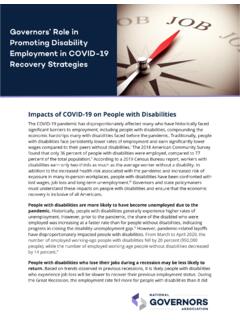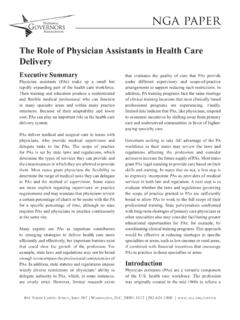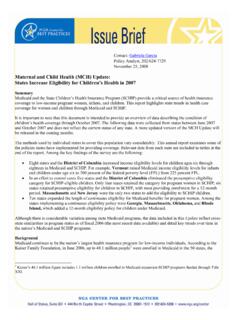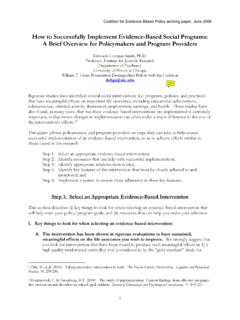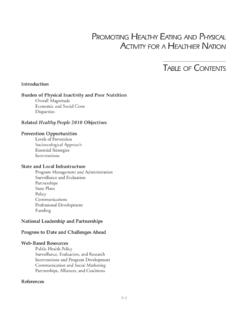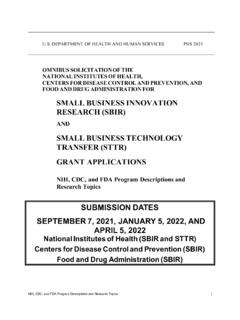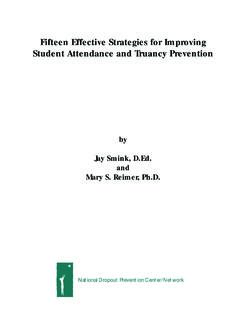Transcription of STATE ACTIONS TO PREVENT AND MITIGATE ADVERSE …
1 STATE ACTIONS TO PREVENT AND MITIGATE ADVERSE CHILDHOOD EXPERIENCESDECEMBER 20212 STATE ACTIONS TO PREVENT AND MITIGATE ADVERSE CHILDHOOD EXPERIENCEEXECUTIVE SUMMARYE xperiencing adversity early in life can affect a person s health, well-being, and success into adulthood. A groundbreaking study by the Centers for Disease Control and Prevention and Kaiser Permanente, released in 1998, found that adults who experienced ADVERSE childhood experiences (ACEs), ranging from physical and emotional abuse, and neglect to various forms of household dysfunction, in sufficient duration and intensity, had significantly elevated risk of heart disease, diabetes, substance use disorder, smoking, poor academic achievement, and early death.
2 COVID-19 has brought additional attention to the impact of ACEs and trauma across the lifespan, which may be exacerbated by disruption in the lives of families; increased family stressors; income, food, and housing insecurity; social isolation; and school closures. Recognizing the critical role that Governors and their staff can play in implementing policies that can PREVENT and MITIGATE ACEs, the National Governors Association Center for Best Practices, in partnership with the Duke-Margolis Center for Health Policy and the National Academy for STATE Health Policy, conducted an intensive, multi- STATE technical assistance project on statewide approaches to address ACEs across the lifespan, starting in June 2020.
3 Across the work with the selected five states, the following areas of focus emerged: } Establishing trauma-informed states by creating a holistic, cross-agency vision for cultural change; } Developing a common, statewide language and lens around trauma and ACEs and implementing universal trauma awareness communications and/or training; } Improving the quality of ACEs surveillance data; and } Increasing access to ACEs screening and developing a comprehensive, trauma-informed system of a capstone of this project, this paper highlights lessons learned from states that served as models for statewide approaches that PREVENT and address ACEs and the development of trauma-informed policies (Alaska, California, New Jersey, and Tennessee).
4 The paper also addresses the goals, policy, and programs developed and launched by states that were selected for the project (Delaware, Maryland, Pennsylvania, Virginia, and Wyoming).COVID-19 HAS BROUGHT ADDITIONAL ATTENTION TO THE IMPACT OF ACES AND TRAUMA ACROSS THE LIFESPAN, WHICH MAY BE EXACERBATED BY DISRUPTION IN THE LIVES OF FAMILIES; INCREASED FAMILY STRESSORS; INCOME, FOOD, AND HOUSING INSECURITY; SOCIAL ISOLATION; AND SCHOOL CLOSURES. STATE ACTIONS TO PREVENT AND MITIGATE ADVERSE CHILDHOOD EXPERIENCES 3 BACKGROUNDA bout ACEsAdverse childhood experiences (ACEs) include experiences such as physical and emotional abuse and neglect, caregiver mental illness, and household violence.
5 Higher exposure to ACEs has been linked with an increased risk for heart disease, diabetes, poor academic achievement, smoking, substance abuse, and even early death. COVID-19 and the declaration of a national emergency in child and adolescent mental health has brought additional attention to the impact of ACEs and trauma across the lifespan. COVID-19 has created disruption in the lives of families; increased family stressors; worsened income, food, and housing insecurity; increased social isolation; and limited identification of needs and access to services and supports due to school closures. Approximately 61 percent of adults have experienced at least one ACE and 16 percent have experienced four or more.
6 ACEs are common across sociodemographic groups; however, they do not impact all sociodemographic subgroups equally. A growing body of evidence demonstrates that Black, Latinx, female, and lower income individuals on average experience more ACEs that White, male, and higher income individuals States, including those participating in the learning collaborative project, are increasingly identifying ACEs and trauma as an important locus for addressing health equity. In addition to personal outcomes, ACEs carry a significant economic burden, including for STATE governments. For example, a 2019 analysis by the Sycamore Institute found that ACEs among adults in Tennessee led to an estimated $ billion in direct medical costs and lost productivity.
7 A 2020 evaluation by the California Surgeon General s office identified the health-related costs of ACEs and toxic stress to the STATE at $ billion Stress and Building ResilienceExposure to ACEs alone does not guarantee that an individual will experience heart disease, diabetes, poor academic achievement, smoking, substance abuse, or early death and some children without significant ACEs may experience some of these outcomes. ACEs interact with preexisting biological and genetic factors as well as with resilience and supportive factors to precipitate health and social outcomes. As demonstrated in Figure 1, ACEs are experienced in combination with environmental and social factors which may contribute to or MITIGATE health and social outcomes and serve as an opportunity for intervention, referred to as the Building community Resilience , experiencing adversity triggers stress response systems in a child s developing brain.
8 Excessive activation of these systems over time can lead to toxic stress, particularly in the absence of protective factors that foster resiliency. Toxic stress can disrupt brain development and lead to social and emotional challenges later in life. Interventions focus on preventing ACEs in the first place, building resilience, and mitigating possible health and social outcomes that may be associated with ACEs. Direct interventions can include fostering strong relationships between children and supportive adults, building life skills across the lifespan, meeting the basic needs of families, incorporating trauma informed practice into service and supports, and providing access to health, behavioral health, and social 1: The Pair of ACEs.
9 4 STATE ACTIONS TO PREVENT AND MITIGATE ADVERSE CHILDHOOD EXPERIENCESTATE STRATEGIES TO PREVENT AND MITIGATE ACESI. Establishing a cross-agency vision for cultural changeCross-sector and cross-agency work is important for aligning policies and resources at the STATE level to target ACEs interventions, from prevention to mitigation. A number of states are addressing ACEs by combatting siloed and disconnected work, including through executive orders, to build a statewide vision and direct STATE agencies to prioritize addressing ACEs and through the establishment of cross-agency teams, work groups, and offices to coordinate ACEs and trauma work. Building Strong Brains Tennessee is a national model for statewide culture change, governance, and public-private partnerships.
10 Building Strong Brains is jointly led by the executive, legislative and judicial branches of STATE government and mobilizes knowledge derived from the science of brain development and communication science, often referred to by Tennessee as a three-branch, two-science approach. Tennessee sought to achieve culture change across all sectors and across all levels of government and community , emphasizing the importance of taking ownership over an individual or group s own sphere of influence (Figure 2). Building Strong Brains credits much of its success to its governance and infrastructure, which relied on the leadership in the three branches of government and its robust partnerships across public and private sectors, and grew out of participating in NGA s and the National Conference for STATE Legislature s Three Branch Institute.
